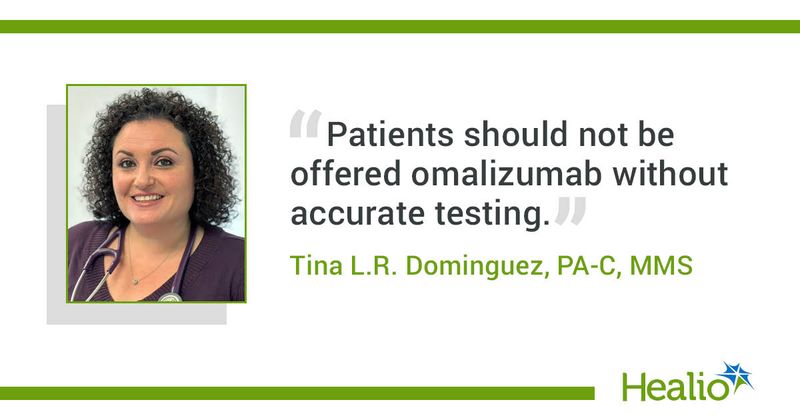Omalizumab rollout for food allergy patients requires care
Click Here to Manage Email Alerts
Key takeaways:
- Omalizumab was used off-label to treat food allergy before its FDA approval.
- Insurance coverage and copays remain inconsistent since approval.
- Patients on oral immunotherapy benefit from omalizumab.
In February, the FDA approved omalizumab for the reduction of food allergic reactions. First approved in 2003 for allergic asthma, this anti-IgE monoclonal antibody developed by Genentech and Novartis inhibits the allergic reaction process.
Preceding the highly anticipated approval, clinical trials demonstrated the power of omalizumab (Xolair) as a monotherapy in patients aged as young as 1 year to increase the threshold for reactions to multiple food allergies.

This means that the use of omalizumab can help to make food-allergic patients safer in classrooms, restaurants and many other settings where there is a risk for cross-contamination or accidental exposure.
Since approval, many patients across the country have eagerly begun food allergy treatment with this injectable medication. At Latitude Food Allergy Care, our providers have offered omalizumab off-label as part of our patients’ personalized treatment plans for many years. Access to the drug for our food allergy patients is now less cost prohibitive. Our current patients on omalizumab range from age 19 months to age 65 years.
But as expected with a new indication for a biologic, insurance coverage remains inconsistent, and out-of-pocket costs for the drug vary depending on independent insurance benefits, copays and personalized treatment plans. Many practices, similar to Latitude, have designated coordinators to assist patients in navigating prior authorizations and appeals with their insurance plans.
For patients, especially our teen, college-age and adult patients, this treatment can be an extra layer of protection in unpredictable environments. The dosing schedule, typically every 2 or 4 weeks, is convenient for many adult patients who can self-administer at home once they have completed three doses under clinical observation. Omalizumab can powerfully help alleviate food-related fear and anxiety and improve quality of life for as long as the patient continues treatment.
However, some parents and patients express misperceptions about the duration of omalizumab treatment, assuming that the medication is a “one-and-done” shot. In fact, omalizumab does not work immediately and should not be used to treat acute allergic reactions. Patients should still always carry two epinephrine autoinjectors.
Omalizumab also can take a few doses to provide protection, and it is not proven to provide lasting immune system changes once the medication has been stopped, so the treatment does require a long-term commitment and regular check-ins with an allergist.
Food allergy testing continues to be a vital part of a complete treatment plan. Patients should not be offered omalizumab without accurate testing, including skin testing, IgE blood testing, and oral food challenges when relevant. Omalizumab dosing for food allergies depends on total IgE blood tests and body weight, and it is only available as an injection.
While the FDA approval designates omalizumab as a monotherapy, prior published research, including my own research experience, has also shown that food allergy patients who begin oral immunotherapy with it benefit from increased safety and long-lasting immunological changes.
With OIT, patients eat gradually increasing amounts of their food allergen over 6 to 9 months to help build up the body’s tolerance to those foods. Patients who use omalizumab may experience fewer side effects during active OIT treatment.
In August, it is expected that the second part of the pivotal study that prompted the FDA approval will be published, evaluating the use of omalizumab as an adjunct for OIT. As food allergy specialists, we hope those study results will help to improve insurance coverage and expand access to treatment options for our patients.
Omalizumab and OIT with it are very exciting options for families that could help them to live life more freely. It is important to acknowledge that food allergy treatment is highly personalized, and I encourage patients to discuss all their treatment options with an allergist who specializes in food allergy.
References:
- Andorf S, et al. Allergy Asthma Clin Immunol. 2017;doi:10.1186/s13223-017-0223-8.
- FDA approves first medication to help reduce reactions to multiple foods after accidental exposure. https://www.fda.gov/news-events/press-announcements/fda-approves-first-medication-help-reduce-allergic-reactions-multiple-foods-after-accidental. Published Feb. 16, 2024. Accessed July 15, 2024.
- Wood RA, et al. N Engl J Med. 2024;doi:10.1056/NEJMoa2312382.
For more information:
Tina L.R. Dominguez, PA-C, MMS, is a food allergy specialist and the East Bay clinical director at Latitude Food Allergy Care clinic in San Ramon, California. She has more than 25 years of experience in medicine and is one of the founding clinicians of the Sean N. Parker Center for Allergy & Asthma Research at Stanford University.
